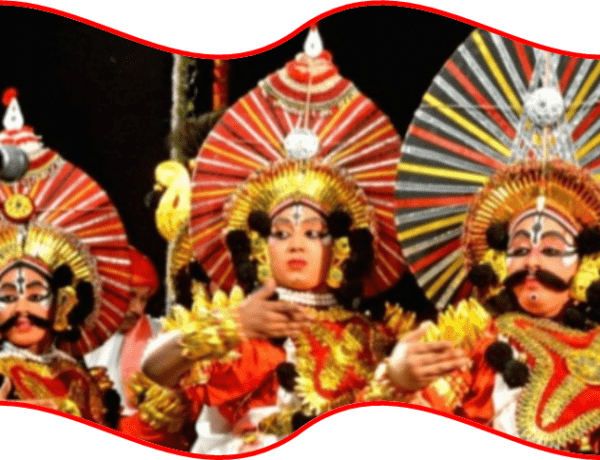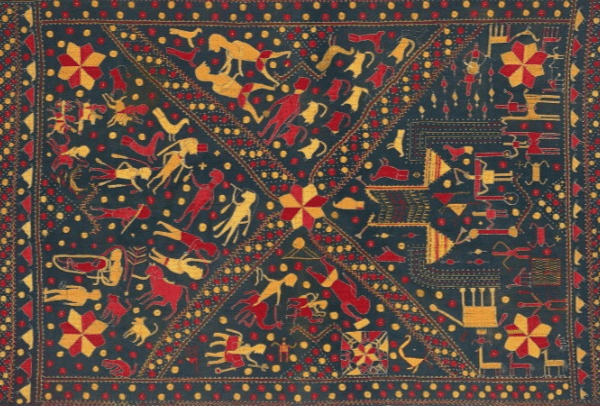A popular statement by Charles Davis very well describes the importance of dance in discovering the culture of any place- “To understand the culture, study the dance. To understand the dance, study the people”. Such thoughts evoked an earnest desire within me to explore about the vivid culture of Gujarat through its traditional dance form- Garba.
Garba is a popular dance form of Gujarat. Both men and women participate in it. It connotes a sense of sincere devotion on their part.
Relevance of Garba
The word “Garba” has its origin in a similar word from Sanskrit language- “Garbha” which signifies womb.
The circular nature of Garbha symbolizes the circle of life which extends from life to death. The presence of the lantern inside the circle reflects the invincible characteristic of the divine light guiding our lives. The lantern is popularly referred to as the “Garbha Deep“.
Another popular notion behind Garba is its close association with the celebration of the fertility on this earth. Therefore, it is also perceived as a sincere acclamation towards womanhood.
The main reason underlying the celebration of Navratri is to celebrate the victory of Goddess Durga. It is also believed that Garba is performed for glorifying the power of the deity. As per the Hindu customs, the term “Navratri” itself denotes the nine nights. All these nights are solely dedicated to celebrate the unhindered courage exhibited by the deity while confronting the evil forces.
People engage in this dance form to showcase their heartfelt pride towards the bravery of Goddess Durga. By performing this art, the Gujaratis tend to uphold the prestige of their esteemed Goddess.
It is also believed that Garba affirms the supreme connection between the dancer, the Goddess and the earth. This has led to carrying out both these dances barefoot in order to exhibit the respect of the individual towards the deity.
The Majestic Dance Form
Garba is also referred to as Garbha, Garbha deep and Garbhi by the localites. Various forms of Garba are prevalent in the Gujarati culture. The two most popular types of Garba includes taali garba (two clap style) and tran garba (three clap style). The dance is full of well- coordinated movements, proper synchronization in clapping and well defined circular moves. This traditional dance form is performed in a circular form around a well lit lanterns which is placed at the centre by following the rhythmic tunes.The lantern is of utmost significance as it represents the sacred feeling of divinity. In order to maintain the festive spirit of the celebration, a lot of musical instruments are played in the background including dhol, drum and shehnai.

The eminence of the songs played during Garba
The themes of the songs played during Garba are based upon the nature and the seasonal cycle along with the desires and aspirations of the women. They provide an enriching insight towards the value and belief system of the society. In addition to this, they also depict the traditional norms laid down for the female section of the society from previous generations. The importance of these songs has been enhanced due to their constant evolution with changing times. New songs are being added to the previous collection in order to signify the transformation in the status of women in the modern society.
The Dearest Ally of Garba- Dandiya
We all have always harboured this belief quite firmly that Dandiya is a part of Garba. We have seen both these dance forms together so often that both of them have become inseparable even in our mindset. However, your general knowledge would go for a toss when I would say that Dandiya is a similar yet different dance form from Garba.
Dandiya is undertaken after worshipping the Goddess Durga. It has very prominent spiritual roots. It basically originated on the lands of Vrindavan. It is also performed to please Lord Krishna. However, it is also performed in combination with Garba.
It basically denotes the battle between Goddess Durga and the King of the demons- Mahishasur. The usage of the bamboo sticks while performing this dance exhibits the mighty swords of Goddess Durga. Therefore, Dandiya is also referred to as the Sword Dance.It is also carried in circles like Garba but the dance moves are even more complicated than Garba.

The dancers use the creative movements of their hands and feet to perform Garbha and the colourful bamboo sticks for carrying out Dandiya.While Garba is performed prior to the worship of the Goddess , Dandiya is undertaken after completion of the religious rituals.In the contemporary Indian families, Garba is performed along with Dandiya.
The Aesthetic Factor
The entire environment is revitalized with the colourful costumes worn by the dancers and the lively folk music played in the background. The vibrant culture of Gujarat is clearly evident in the enthusiastic atmosphere created by the zealous participation of the people in these Dance forms. These art forms also denote a very significant lesson linked with the core spirit behind the celebration of the Navratri festival.

The glimpse of the Gujarati culture can be found in the traditional costumes worn by the people while they immerse themselves in the festive spirit.
These costumes have fascinated all of us at some point of time. It would not be called an exaggeration on my part if I say that they are the real reason behind our genuine love towards Garba. Am I right???
Men are seen wearing the Kurta- Pajama. Traditionally, the male attrire is called Kediya. Women on the other hand wear the Chaniya Choli. The aesthetic characteristics of these outfits are the comprehensive embroidery and mirror work on the surface along with the bright colors. However, the imprint of the cosmopolitan culture is evident in the outfits of the women as well as some of them do prefer the sarees designed by popular fashion labels along with the lehenga sarees while participating in Garba and Dandiya.
Traces of Gujarati Culture
A very interesting fact about the movements in Garba is their inclusivity which can provide a true picture about the cultural values of Gujarat to any stranger.The artists perform quite easy dance movements in order to ensure participation from the people from all age groups and with diverse skills. This illustrates the collective mindset of the people belonging to the Gujarati culture. It also signifies their concern for everyone around them.The similar traditional attire worn by all the people indulging in these dance forms connote the sense of unity amongst them and helps in witnessing the much needed feeling of togetherness.

The Modern Perspective
The modern civilization has transformed this traditional practice into a mega social event. The charm towards these dance forms has spread within the entire nation. We all are aware about some or the other place in our respective cities where dandiya or garba nights are organized. They have become a prominent part of the Navratri celebrations across India. Dandiya Nights and Garba nights have actually become a grand affair and a highly glorified event organized by the renowned event management organizations.
I hope the next time you all attend the Dandiya or the Garba night, you would be able to appreciate the true beauty of Garba and understand the nuances involved in this dance form. Hope you acknowledge its significance beyond the melodious songs played during Garba!! Let the enjoyment of the festivities become more meaningful!!






No Comments